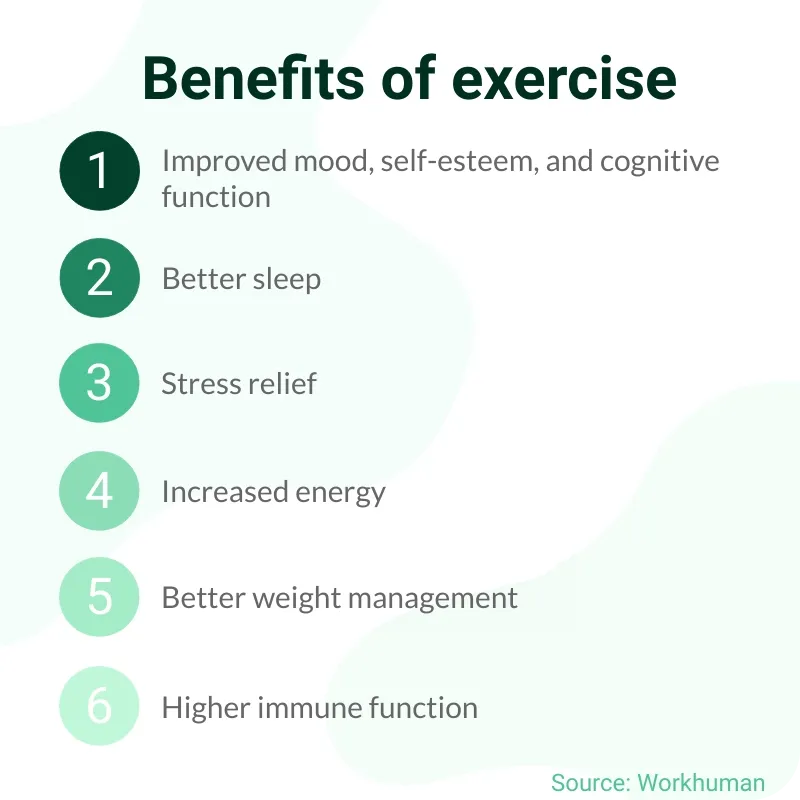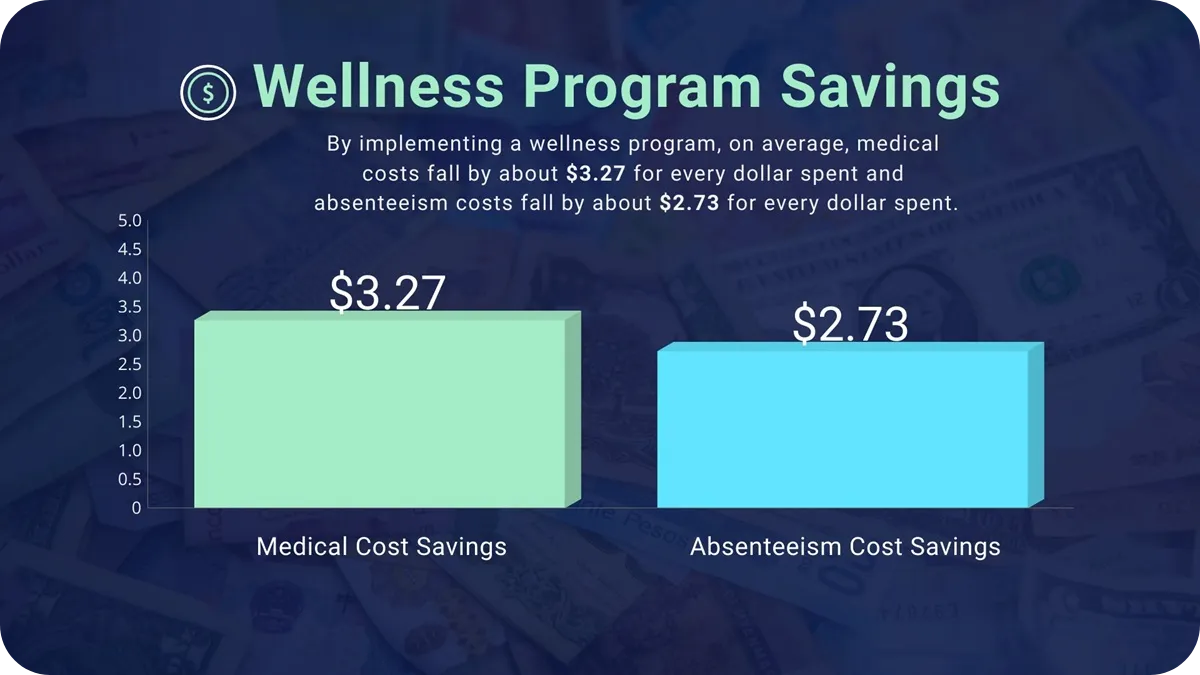Why Physical Wellbeing at Work Matters

When you’re thinking about wellbeing at work, are you taking physical wellness into account? It’s an often overlooked but undeniably relevant part of overall wellness. In fact, no singular facet of wellness exists in a vacuum – emotional, physical, and social wellbeing are all connected.
And when one element is compromised, the rest of the system feels the effects. Think about how you’re not supposed to drive when you’re tired. Similarly, you can’t expect to do your best work if your body is exhausted, stressed, stiff, and generally unhealthy.
Being sedentary has known consequencesOpens in a new tab , including poor heart health, low energy, and low mood. Even if you don’t feel the impact, the compounding effects affect us all in one way or another, whether through physical discomfort or perpetual fatigue.
Regular breaks at work boost productivity and creativity. While it may seem counterintuitive to think of breaks as productive, it’s time to update our thinking. Prioritizing physical wellbeing is key to a thriving workforce.
The good news is that even short breaks can have a measurable impact. So, let’s talk about physical wellbeing at work, why it matters, and how you can promote it in your organization for a happier, healthier workforce.
What does physical wellness at work mean?
Physical wellbeing is comprised of our sleeping, eating, and exercise habits, all of which influence energy levels. At work, this means regular breaks for quick bouts of exercise and stretching.
People spend an average of nearly six hours per day sitting during the working week. The same study also showed that those who sit longer at work at more likely to sit outside work – all of which correlates with a higher BMI and a decrease in mental wellbeing.
A sedentary lifestyle is connected to poor sleep, which impacts immunity (think more missed days), mood (think poor team dynamics), and cognitive ability (think of avoidable mistakes and missed deadlines).
The New York Times draws an even more alarming conclusion: Every waking hour spent in sedentary postures (sitting or lying) increases the risk for metabolic syndrome and Type 2 diabetes.
For the average office worker, this paints a bleak picture. But there’s hope: Even quick, three-minute breaks with as few as 15 steps can help combat some of the negative effects of sitting.
On the other hand, the benefits of exercise are nearly endless:

All of this adds up to a healthier, happier, more engaged, and more productive workforce. What’s more, it is proven that businesses that promote employee health tend to be the most successful. Why?
Because they have mentally and physically healthy employees who use less sick leave, produce higher output and quality, and experience less turnover.
So, how can you reap these benefits in your wellness program?
The importance of workplace wellbeing
Workplace wellbeing programs are critical to keeping workers healthy and engaged. In fact, they’re a win-win, supporting employees’ health while also boosting organizational productivity.
Employee wellness is not something to take lightly, as our recent research with Gallup has confirmed. For more insights into the benefits wellbeing can have on your workplace, check out this report.
These programs are designed to improve or promote employee health by offering health screening, smoking cessation protocols, healthy movement, and more as part of the overall employee benefits package.
One 2010 study found that "medical costs fall by about $3.27 for every dollar spent on wellness programs and that absenteeism costs fall by about $2.73 for every dollar spent." These savings add up to fewer missed days and higher overall engagement.

How? Wellness programs touch on every aspect of wellbeing:
Physical: Healthy employees are simply more productive. A sedentary lifestyle is a recipe for chronic health issues, making exercise in the workplace all the more important. Emotional and mental: Stressed employees don’t make for a great work environment. Lowering stress and promoting mindfulness is a great way to cultivate a strong work culture. Intellectual: Healthier people have better memory, stronger cognitive function, and increased creativity.Environmental: Wellbeing includes sustainability, which impacts us all. People get a feel-good boost from helping out the planet.Social: These programs are designed to support the whole of an organization. They should be a collaborative shared experience, facilitating camaraderie and a sense of community.All of this helps alleviate stress and burnout, making for a more resilient team and an overall more positive work environment.
What’s more, these kinds of initiatives are really valued by talent. Nearly 9 in 10 employees consider the benefits package when evaluating an employer. More than half of Gen Zers and millennials consider wellness programs important or extremely important when looking for a job.
How to facilitate physical wellbeing at work
A sedentary lifestyle is linked to premature morbidity and overall higher health risks. Even brief breaks make workers feel more positive and connected, all of which help alleviate stress and burnout, making for a more resilient team and an overall more positive work environment.
It’s crucial to facilitate a consistent movement practice with enforced guidelines that are regularly encouraged within the culture. This doesn’t mean requiring a 15-minute afternoon walk every day (though there are certainly employees who would enjoy that). Rather, there should be flexibility within a logical structure.
Plan to take quick breaks during longer meetings. Offer optional activities at least a few times a week, like a walk, stretch break, or yoga flow. Encourage employees to share their activity plans to get others to join in.
Don’t overcomplicate it – just a 15-minute break can lead to reduced stress and promoted enjoyment, facilitating behavior change and improving workplace social interaction. The what of it is less important than the how, ensuring that you get employees to participate in a meaningful way.
In one study where workers took a 15-minute physical activity break every workday for 6-12 months, participants said the breaks helped clear their mind, rejuvenated their energy, improved their focus, and strengthened their relationships with coworkers. They even said it was fun!
Here are some tips for introducing physical activity breaks at work:
- Know the bare minimum. Standing up and moving every 30 minutes for about three minutes may lessen the health impacts of over-sitting.
- Offer a variety of options. The main feedback from participants in the aforementioned study was that they wanted greater variety in their activity breaks after following the same routine for the duration of the study.
- Embed it in your culture. Everyone from new hires to executives should be aware of the activity break offerings and should be encouraged to participate. Have regular breaks throughout the week and motivate employees to share their plans to join the activity of the day or share what they get out of the breaks. Create a specific Slack or Teams channel dedicated to these initiatives to share the latest schedule and keep the good vibes going.
- Make the options realistic and accessible. People have varying physical abilities. Take this into account as you design your wellness program, and be sure to offer activity breaks that work for everyone.
- Activity breaks at the desk include standing and stretching, jumping jacks, squats, and meditation.
- Activity breaks away from the desk include yoga, walking, or an exercise circuit.
For more ideas on how to incorporate physical wellness into your corporate wellbeing program, check out this guide about "physical activity breaks for the workplaceOpens in a new tab" from the Centers of Disease Control and Prevention.
Conclusion
Your company cannot succeed without healthy employees. Take time to understand their needs and desires for physical activity breaks and incorporate this thoughtfully into your overall wellbeing program.
Remember: these breaks should be fun! Consider them to be another opportunity for your work culture to thrive while benefiting both your employees and company at large.
About the author
Maeve Ginsberg
A wellness enthusiast and the mid-day walk’s #1 fan, Maeve champions work-life balance.
Having gone from a corporate job to self employment, Maeve has lived through countless working styles. This evolution forced confrontation of her own limiting beliefs, eventually breeding a completely individualized approach to work and productivity.
As a Senior Copywriter, Maeve often writes on workplace wellbeing and strives to advocate for all workers and leaders to find small yet significant ways to make their work lives healthier and more fulfilling.
Offline, Maeve enjoys testing new cuisines and hanging upside down off walls (also known as bouldering).